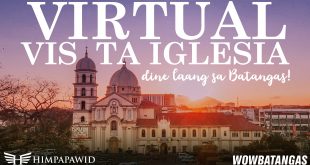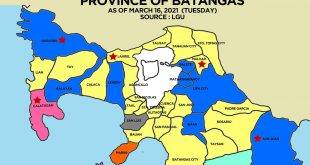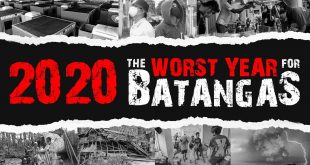Visit the Balayan, Batangas page for all information on Balayan.
Balayan is home to the famous Parada ng Lechon. This is a first class municipality in the 1st District of Batangas. Get to know the history of Balayan below.
The word “BALAYAN” came from the word BA-I or balai which means house in Sri-Visayan dialect. Later the Filipino suffix “an” was added, thus the word Balayan was coined. This can also mean a group of house or settlement.
During the early days, the natives used to construct their houses on stills above the waters of Balayan Bay. It is said that when the Spaniards arrived the shores of Balayan it was already populated by the descendants of the two Bornean datus who settled in this place. Historians believe that Balayan is the center of the ancient powerful kingdom of MA-I.
The historic beginnings of Balayan which date back to the early 11th to 13th century as chronicled by Chinese historic accounts was a trading port as what they termed the “South Seas” of the barbarians, where Malays, Mongolians and Australians transported their goods for barter with products of the natives, which is believed to be the adobe of the “Tayakads” and the “Sagubangs”, the early inhabitants of Balayan who fled to the mythical mountain called Batulao, the home of King Suay and Queen Dalisay, the parents of Princess Tagaytay when the Bornean Datus arrived.
The settlement lies on the shores of a vast body of water which was later on called “Kumintang” or “Bonbon”. The people lived along the lands of the sea as well as on the lands of a big river coming from the fabled mountain of “Batung Dilao”, where Datu Balensusa and Datung Dumangsil, two of the ten datus who purchased Panay, arrived and settled when they were blown by winds when they tried to return home. Later Datu Dumangsil sailed northward and Datu Balensusa was left behind in what was then called Bonvon. The last Malayan ruler, one of his descendants, Datu Kumingtang, stayed in what is now called Pook and died there.
On May 8, 1570, the Spaniards first set foot on the shores of Balayan, headed by Mashal Martin de Goiti and Captain Juan Salcedo, and found that this place was a thriving community. Later Balayan was rewarded to De Goiti as his encomienda while villa Fernandina in Vigan Ilocos Sur became Salcedo’s encomienda.
In 1572, the Augustinian Friars planted the first cross somewhere in Barangay Lanatan and put a chapel of weak materials. However, the church did not last long for it was destroyed by barbaric natives. In 1575, another church was constructed in Brgy. Ibabao, whose remnants are still visible like the stone altar, thus mission of the religious fathers started. Balayan became the center of Christianity and cradle of civilization in the whole Southern Luzon.
In 1578, Balayan was officially establish as a Municipality in the name of the king of Spain and was founded by two Franciscan friars, Fray Esteban Ortiz and Fray Juan de Porras. The area covered what is now called the town of Nasugbu, Lian, Tuy, Calaca and Calatagan. From 1581 until 1732 Balayan became a province for 151 years.
The province of Balayan extended up to province of what Batangas, Marinduque, Mindoro, southern parts of Laguna and Quezon up to Camarines. The people had their own civilization and culture much advanced than those from other places at that time. The institutional hub of the seat of the town proper was moved and fortified from the shorelines to its present site for security purpose and haven for refuge against natural calamities as the rampaging waters and manmade hostilities brought by the Muslim attackers at that time.
In 1591, the church was constructed and blessed by. Fr. Pedro Chirino, S.J. In 1749, the construction of the stone church started. Stone walls in front of the church patio were erected to hold waters and fortress were built to ward off attackers. Some remnants of the stone walls are still visible at present. Balayan used to be a part of the Archdiocese of manila until the time the bishopric of Lipa was established. In 1795, the stone church was blessed and dedicated in honor of the Immaculate Conception, the Patroness of Balayan.
In 1838, the Municipality of Calaca was established and separated from the town of Balayan, However, the same was returned to Balayan in 1903 and re-established in 1903. In 1939, the towns of Nasugbu and Lian were established and became independent towns. However, the town of Lian was annexed to Nasugbu in 1903 until 1915. In 1845, the town of Calatagan was established and separate from Balayan but was returned to Balayan in 1903 and re-established in 1912. In 1855, barrios were established and there at least nineteen original barrios in Balayan. In 1867, the town of Tuy was established and separate from Balayan. However, it was returned to Balayan in 1903 until 1911.
With the succeeding regimes of foreign dominations and aggression of the country, the municipality has been under military occupations: First under Gen. Bell of the American expeditionary Force and during the Japanese Military occupation in 1941. After the liberation in 1945, Balayan remained as the center of trade, industry as well as education in the first district.
In not-so-distant past, Batangas Sugar Central has been established, further enhancing the development of the municipality into an agricultural community. Obviously with recently LANDCO PACIFIC, a tourist-oriented resort and STEEL CORPORATION of the Philippines, a galvanized iron cold manufacturing company, probably the biggest in Asia were among that gave additional income to Balayan. Likewise, Balayan is a co-host of the National Power Corporation Coal Thermal Plant in Calaca, Batangas for there are at least thirty five hectares of land where the said company stands.
It is our vision to see Balayan in the near future as a modern Agro-industrial community, a self-sufficient socio-economic unit providing livelihood, education, health services, food production and other needed infrastructure based on indigenous culture, local customs and traditional values.
• The first municipality in Southern Tagalog and the first province on Southern Luzon.
• The cradle of Christianity and seat of civilization in this part of the country.
• The home of delicious Bagoong and sumptuous Lechon.
• The home of STEELCORP, Asian’s biggest cold rolling steel mill and co-host of the NATIONAL POWERCORPORATION, a Coal-Thermal plant.
• A Progressive Agri-Industrial Community, a conducive haven of high moral-centered people and highly competitive globally.
Last Updated: September 10, 2013
 WOWBatangas.com Your Source of Great News and Stories from the Province of Batangas, Philippines
WOWBatangas.com Your Source of Great News and Stories from the Province of Batangas, Philippines




destroyed by “barbaric natives” — do we have call them barbaric…they are our ancestors and fighting for their freedom and their way of life. Spaniards can call them barbaric..but we as natives of Batangas should call them.. heroes..fighting for their homeland against the invaders..We must change most of the words used by the Spanish and Americans in our history books